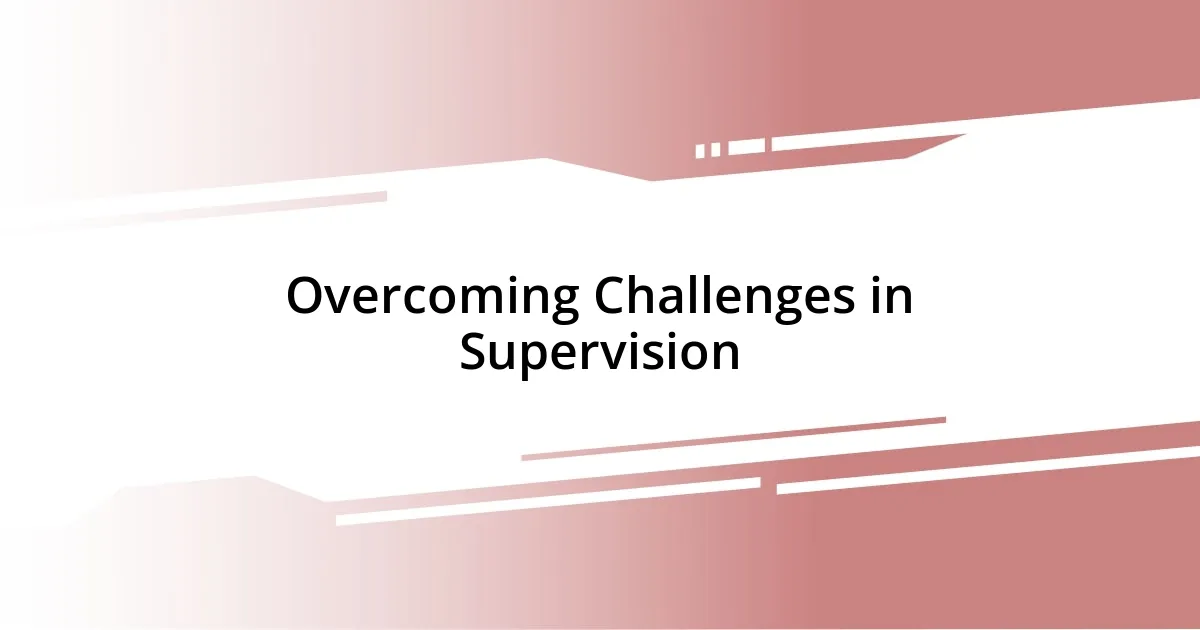Key takeaways:
- Reflective supervision fosters self-awareness and emotional insight, allowing professionals to explore the impact of their emotions on their practice.
- Key components of effective reflective supervision include creating a safe environment, encouraging critical thinking, and maintaining regularity in sessions.
- Techniques such as journaling, role-playing, and requesting feedback enhance the reflective process and improve professional development.
- Measuring the impact of supervision can be achieved through observing changes in client interactions, tracking outcomes, and gathering client feedback.

Understanding Reflective Supervision
Reflective supervision, at its core, is a space for deep thinking about our work, allowing us to explore the emotional and practical aspects of our professional experiences. I remember a time when I felt overwhelmed by a particularly challenging case. During a reflective supervision session, I was not only able to unpack my feelings but also gain fresh insights that transformed my approach to supporting the individual involved.
This process isn’t just about assessing our professional skills; it’s significantly about understanding our emotional responses and how they impact our work. Have you ever found yourself emotionally drained after a tough day? I certainly have, and those moments made me realize how crucial it is to reflect on why certain situations affect me so deeply. By discussing these feelings in supervision, I started to develop strategies that not only helped me cope but enriched my practice.
The beauty of reflective supervision lies in its collaborative nature. It’s not just about receiving feedback; it’s about engaging in a meaningful dialogue where we can challenge our thinking and explore new perspectives. I cherish those moments when my supervisor posed a question that caught me off guard, prompting me to think in ways I hadn’t considered before. These insights lead to growth, not just as a professional, but as a person navigating the complexities of my field.

Benefits of Reflective Supervision
Reflective supervision offers numerous benefits that can deeply enhance our professional development. For me, it’s like a safety net during uncertain times. I recall a moment when I felt stuck in my practice; by discussing my doubts in supervision, I gained clarity and a renewed sense of purpose that propelled me forward. This process reminds me that we’re never alone in our struggles—our supervisors are there to support us and help us grow.
Here are some key benefits of reflective supervision:
- Enhanced Self-Awareness: By exploring our feelings and experiences, we become more mindful of how our emotions influence our decisions.
- Improved Problem-Solving: Reflective dialogues encourage creative thinking, allowing us to view challenges from different angles.
- Increased Confidence: Regularly discussing our practice helps solidify our skills and reassures us that we’re on the right track.
- Stronger Relationships: Building a rapport with supervisors fosters trust and a safe space for open conversations.
- Better Outcomes for Clients: With a clearer understanding of our professional selves, we can provide more effective support to those we serve.
Each of these aspects reflects how transformative and, at times, grounding reflective supervision can truly be.

Key Components of Reflective Supervision
Reflective supervision is underpinned by several key components that shape its effectiveness. One critical element is the establishment of a safe and supportive environment. I vividly recall a session where my supervisor offered me a judgment-free space. This felt invaluable; instead of feeling like I was under a microscope, I could honestly share my thoughts and feelings without fear of repercussion, which encouraged deeper exploration of my experiences.
Another essential component is the focus on critical thinking. During reflective supervision, I often find myself dissecting past encounters with clients or colleagues. For instance, I once analyzed a difficult interaction I had with a client. My supervisor prompted me to consider different perspectives, which challenged my initial assumptions and led me to develop a much more effective approach the next time we met.
Regularity is also key in reflective supervision. Consistency in meetings allows for the ongoing development of thoughts and insights. I remember when my sessions became a weekly routine; this structure helped me identify patterns in my emotional responses over time. These repeated reflections not only provided clarity but also cultivated a deeper understanding of how my personal experiences influenced my professional decisions.
| Key Components | Description |
|---|---|
| Safe Environment | A supportive space for open dialogue and emotional exploration. |
| Critical Thinking | Encouraging analysis of situations to gain new insights and perspectives. |
| Regularity | Consistent meetings to track progress and develop a deeper understanding. |

My Personal Approach to Supervision
In my personal approach to supervision, I prioritize creating a space that feels genuinely safe and open. I remember one particular session where I shared a failure I had experienced with a project. As I spoke, I could feel the weight of shame lifting off my shoulders, and my supervisor’s supportive words reminded me that mistakes are stepping stones rather than stumbling blocks. Have you ever had a moment when vulnerability turned into an unexpected source of strength? That experience reshaped how I view challenges in my practice.
Moreover, I actively cultivate a habit of reflective questioning during supervision. I often ask myself and my supervisor, “What can I learn from this experience?” This simple query sparks deeper conversations about my assumptions and perspectives. It was during one session that I recounted a case that troubled me. The discussion opened my eyes to emotional biases I hadn’t acknowledged before, changing my interactions with clients in subtle yet meaningful ways.
Finally, I believe in the importance of maintaining regularity in our meetings. Establishing a rhythm makes it easier to track my growth over time. I find myself looking forward to these sessions as checkpoints for reflection and connection. Have you noticed how consistent engagement can transform your practice? I know that when my sessions are frequent, my insights become richer, and I leave feeling re-energized and ready to tackle any challenges that come my way.

Techniques for Effective Reflection
One technique that has profoundly impacted my reflective practice is employing journaling. After each supervision session, I take a moment to jot down my thoughts and feelings about the discussions we had. I once found myself scribbling about a particularly intense session where I confronted my fears regarding a client’s well-being. Writing it down not only helped me process the emotions I was feeling in that moment, but it also allowed me to revisit those insights later, shedding light on my growth. Have you ever tried journaling after reflective conversations? If so, did you notice how it clarifies your thoughts?
Another effective technique I use is role-playing difficult scenarios during supervision. This practice helps me step into different perspectives, which is essential when working with clients. I recall simulating a challenging dialogue where I had to address a conflict with a colleague. As we role-played, my supervisor stepped in, asking probing questions that led me to realize how my body language affected the conversation. It’s fascinating how this creative approach opens up new understanding, isn’t it?
Lastly, I embrace the power of feedback in my reflective supervision. Soliciting constructive criticism from my supervisor has transformed my practice. For example, during one session, I asked for feedback about my engagement style with clients. My supervisor pointed out moments when I could enhance my active listening skills. This feedback didn’t just feel like a critique; it felt like a guide towards becoming a more effective practitioner. How do you integrate feedback in your reflective processes? For me, it’s a continual journey of improvement, and I’m always eager to learn.

Overcoming Challenges in Supervision
Overcoming challenges in supervision often requires a delicate balance of honesty and compassion. I remember a particularly challenging moment when a supervisor provided feedback that felt unfair. Instead of reacting defensively, I took a step back and asked myself, “What truth is embedded in this criticism?” That shift in perspective allowed me to extract valuable insights, transforming an uncomfortable moment into a learning opportunity.
Engagement can sometimes wane during supervision, creating additional barriers. I once found myself drifting in a session, feeling disconnected from the discussion. In that moment, I decided to re-engage by sharing a personal story about a tough decision I faced. The resulting conversation not only revitalized the session but also deepened our mutual understanding. Have you ever found that sharing a vulnerable experience can rekindle a lost connection? It’s remarkable how authenticity can revive energy and focus.
Lastly, managing the emotions that come with supervision can be tricky. During one session, I felt overwhelmed after discussing a particularly heart-wrenching case. Instead of brushing it aside, I chose to express my feelings openly. It was freeing to acknowledge my emotional state, and it sparked a rich dialogue about self-care strategies we can adopt as practitioners. How often do we allow ourselves to feel in supervision? This experience taught me that embracing emotions can facilitate discussion, turning challenges into building blocks for resilience.

Measuring the Impact of Supervision
Measuring the impact of supervision can feel nebulous, but I’ve found it often reveals itself through tangible changes in my practice. After implementing new strategies discussed during supervision, I’ve noticed a marked shift in my interactions with clients. For instance, after focusing on active listening techniques, I realized that my clients felt more heard and understood, which in turn fostered deeper connections. Have you ever reflected on how your practice evolved after a pivotal supervisory discussion?
In my experience, I’ve also seen that quantitative measures, like tracking client outcomes, can effectively highlight the benefits of supervision. During one supervision cycle, we decided to chart the progress of several clients over a few months. The data showed a significant improvement in terms of engagement and satisfaction levels. It was enlightening to witness how much our focused discussions had contributed to those positive outcomes. Do you ever use metrics to assess the efficacy of your supervision?
Lastly, I’ve found that gathering feedback from clients serves as an invaluable tool for gauging the impact of supervision. After a session where I’d particularly leaned on insights gained in supervision, I asked a client for their thoughts. They expressed feeling empowered and more validated, reinforcing that the support I received was instrumental. It’s incredible how directly asking for input can create a loop of growth, isn’t it? This iterative process of reflection helps me continually refine my approach, ensuring that supervision isn’t just about my development, but genuinely enhances client experiences too.














